Herbal Extract Products Market Research, 2032
The global herbal extract products market size was valued at $28.0 billion in 2022, and is projected to reach $85.1 billion by 2032, growing at a CAGR of 11.9% from 2023 to 2032.
Report Key Highlighters:
- The global herbal extract products market has been analyzed in terms of value ($Million). The analysis in the report is provided on the basis of type, application, 4 major regions, and more than 15 countries.
- The global herbal extract products market report includes a detailed study covering underlying factors influencing the industry opportunities and trends.
- The herbal extract products market is fragmented in nature with few players such as Bio-Botanica, DKSH Holding Ltd., Hunan NutraMax Inc., Mane Kancor Ingredients Private Limited, Martin Bauer, Nexira, Organic Herb Inc., Ozone Naturals, Sabinsa, and Vidya Herbs Pvt. Ltd.
- The report facilitates strategy planning and industry dynamics to enhance decision-making for existing market players and new entrants entering the herbal extract products industry.
- Countries such as China, U.S., India, Germany, and Brazil hold a significant share in the global herbal extract products market share.
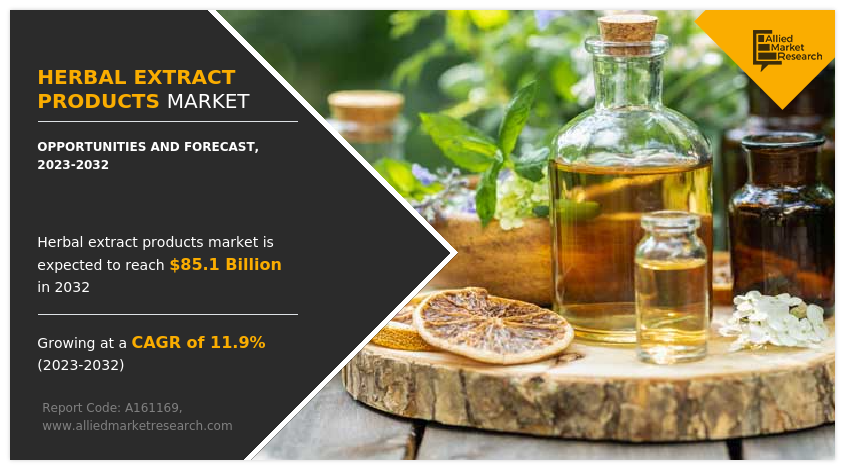
Herbal extract products are formulations derived from plants and capture their bioactive compounds through various extraction methods. These products increase the therapeutic potential of botanical sources by concentrating their beneficial constituents, such as phytochemicals, essential oils, and other plant compounds. Extraction processes involve solvents, heat, pressure, or mechanical means to isolate these active components, resulting in potent and concentrated forms of the plant properties.
The extraction process involves isolating and concentrating specific compounds or active ingredients from plant material. This is done through methods such as solvent extraction, steam distillation, cold pressing, or using innovative techniques such as supercritical fluid extraction. These methods aim to preserve the potency and beneficial properties of the botanicals.
The extraction, manufacturing, and incorporation of bioactive compounds into different formulations have been revolutionized by advancements in extraction and manufacturing technologies within the herbal extract product industry. These advancements aim to enhance efficiency, improve product quality, and increase the sustainability of herbal extract production. Moreover, the integration of novel technologies such as microwave-assisted extraction (MAE) and pulsed electric field (PEF) extraction has streamlined the processes. All these factors are expected to drive the growth of the herbal extract product during the forecast period.
However, the bioavailability of active compounds in herbal extracts varies which affects the absorption and utilization of these compounds. Factors such as formulation, dosage form, and individual variations in metabolism impact the absorption rate, potentially causing delays in therapeutic effects. All these factors allow consumers to choose alternatives over herbal extract products, which hampers market growth.
Increases in R&D investments enable advancements in extraction methods, formulation techniques, and quality control processes. This leads to standardized, high-quality herbal extract products with consistent potency and purity, ensuring consumer confidence and safety. In addition, investments in R&D contribute to generating scientific data and educational resources that educate consumers and healthcare professionals about the benefits, usage, and safety of herbal extract products. All these factors are anticipated to offer new growth opportunities in the herbal extract products market forecast.
The herbal extract product market is segmented on the basis of type, raw material, end-use industry, and region. On the basis of type, the market is segmented into alcohol-based extract, powder-based extract, and oil-based extract. On the basis of raw material, the market is divided into berries, bark, leaves, roots, flowers, fruits, aromatic herbs, and others. On the basis of end-use industry, the market is segmented into food & beverage, cosmetics & personal care, pharmaceuticals, and others. By region, the market is analyzed across North America, Europe, Asia-Pacific, and LAMEA.
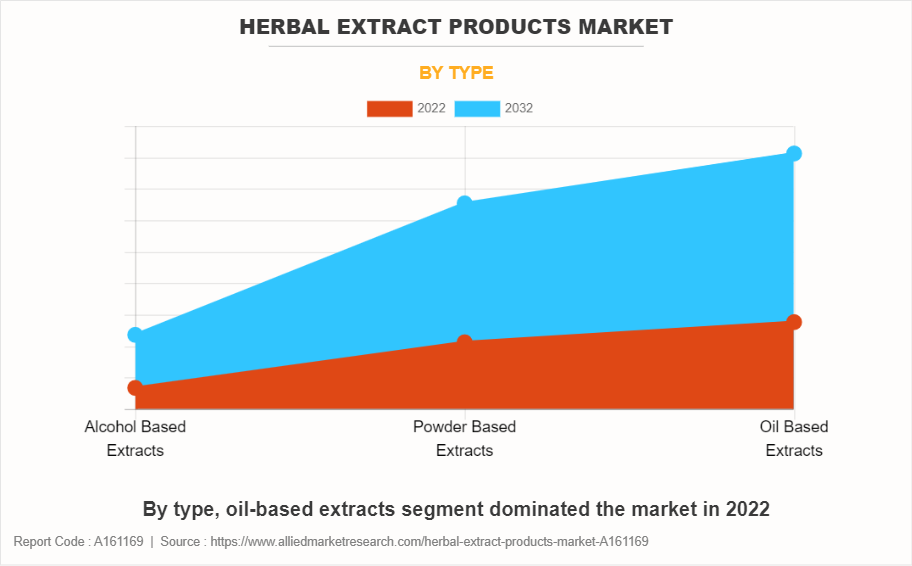
The rising consumer preference for natural and organic ingredients has propelled the demand for oil-based herbal extracts. Consumers seek products that are free from synthetic additives and chemicals, preferring instead the holistic benefits offered by plant-derived oils. Moreover, ongoing research and innovation in extraction techniques have enhanced the quality and purity of oil-based herbal extracts. All these factors increase the demand for the oil-based extract.
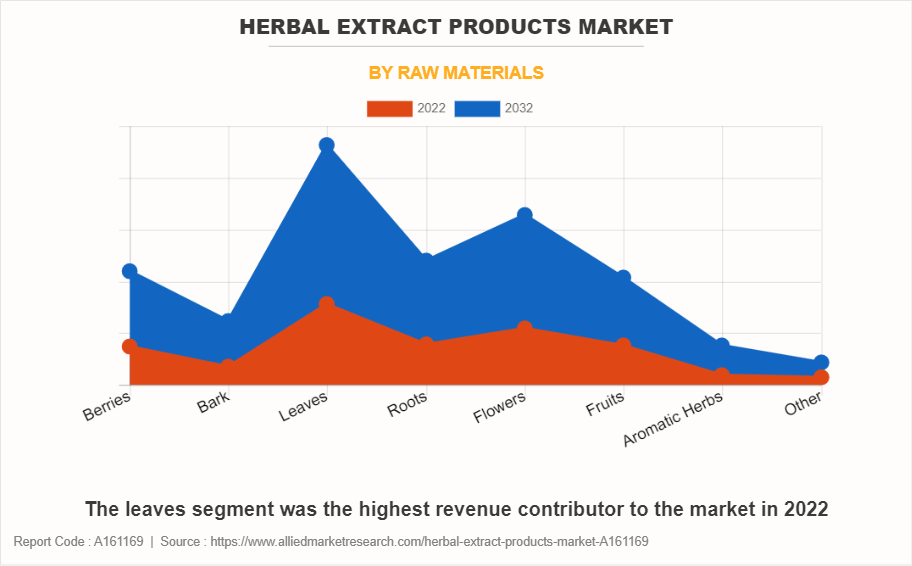
Leaves are rich in bioactive compounds and phytochemicals known for their therapeutic properties which attract attention due to their potential health benefits. In addition, an increasing demand for natural and plant-based ingredients in various products such as skincare, supplements, and medicinal items, is steering the use of leaf extracts. Additionally, advancements in extraction technologies have enhanced the efficiency of extracting bioactive compounds from leaves, contributing to the growth of this segment within the herbal extract products market.
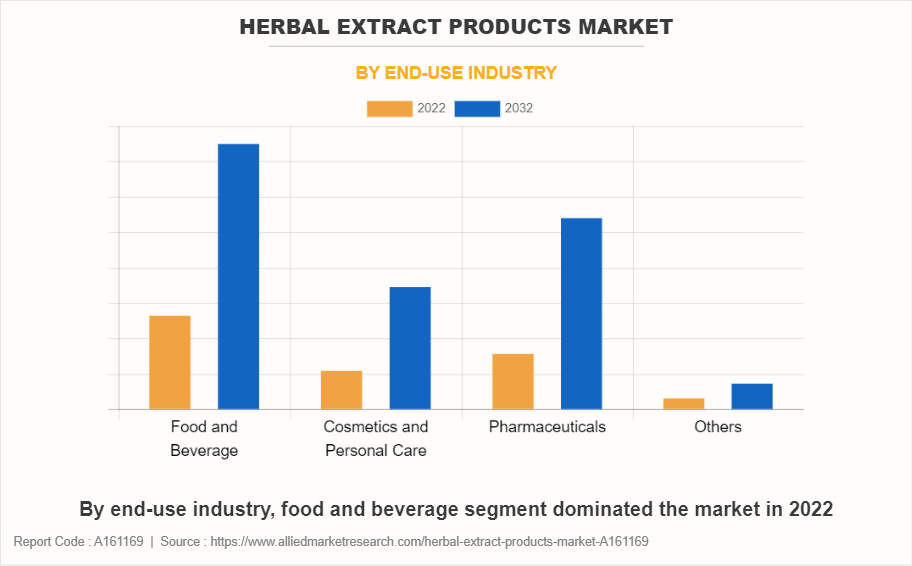
Consumers are increasingly seeking healthier and more natural alternatives, prompting food and beverage companies to incorporate herbal extracts for their perceived health benefits. These extracts offer a diverse range of flavors, functional properties, and potential health advantages. Moreover, the emphasis on sustainability and environmentally friendly practices has further boosted the use of herbal extracts in food and beverage formulations.
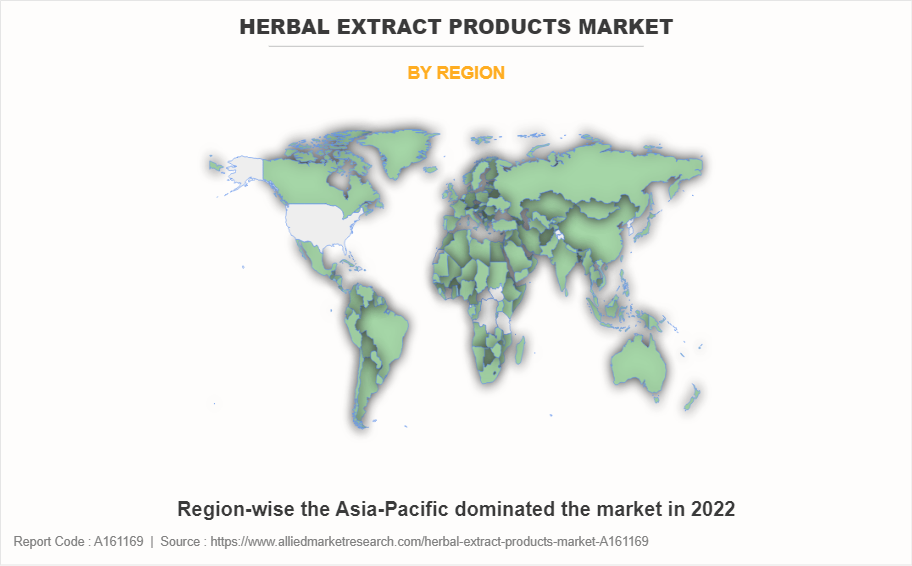
The rich biodiversity in the Asia-Pacific offers a vast array of botanical resources, contributing to the availability of diverse and unique herbal extracts. Additionally, traditional medicinal practices deeply rooted in countries across Asia-Pacific such as Ayurveda, Traditional Chinese Medicine (TCM), and Kampo have fostered a cultural inclination towards herbal remedies. This cultural heritage acts as a significant catalyst that drives the consumption and production of herbal extract products.
Key players in the herbal extract products industry include Bio-Botanica, DKSH Holding Ltd., Hunan NutraMax Inc., Mane Kancor Ingredients Private Limited, Martin Bauer, Nexira, Organic Herb Inc., Ozone Naturals, Sabinsa, and Vidya Herbs Pvt. Ltd.
Apart from these major players, there are other key players in the herbal extract products market growth. These include A.G. Industries, Arjuna Natural Pvt. Ltd., Firmenich SA, Flavex Naturextrakte GmbH, Herbochem, India Essential Oils, Kalsec Inc., Ransom Naturals Ltd., Robertet Group, S.A. Herbal Bioactives LLP, Sami Spices, Symrise, Synthite Industries Ltd., Döhler GmbH, and Pioneer Enterprise.
Historical Trends Of Herbal Extract Products Market:
- The use of herbal extracts for medicinal purposes dates back centuries, but formal documentation and early extraction methods emerged in the late 19th century. This era witnessed initial experiments and documentation of extraction techniques used to derive medicinal compounds from plants. These extracts were primarily utilized in traditional medicine and home remedies.
- During the mid-20th century, advancements in technology and scientific understanding propelled the extraction processes forward. Innovations in extraction methods such as solvent extraction and distillation enabled more efficient isolation of active compounds from various herbs. However, the mainstream adoption of herbal extracts in modern medicine remained limited due to a lack of standardized processes and skepticism within the scientific community.
- In the late 20th century, growing interest in natural remedies and alternative medicine spurred increased attention towards herbal extracts. Scientific research into the pharmacological properties of plant compounds gained momentum. This period saw some regulatory efforts to standardize extraction methods and quality control in the production of herbal extract products, leading to their gradual acceptance in certain markets.
- The early 21st century concerns regarding synthetic pharmaceutical side effects and a broader shift toward wellness and natural living drove a surge in the popularity of herbal extract products. Improved extraction techniques such as supercritical CO2 extraction and advanced chromatography methods enhanced the purity and concentration of active compounds. Regulatory bodies began to establish clearer guidelines for the manufacturing and marketing of herbal extracts, contributing to their growing credibility.
- By the mid-2010s, the herbal extract market experienced notable growth globally. Increased consumer awareness of health and wellness, coupled with a preference for natural remedies, expanded the demand for standardized and high-quality herbal extract products. Research into the therapeutic properties of various plant extracts gained prominence, leading to the development of novel formulations and combinations.
- In the late 2010s and early 2020s, accelerated research and development efforts focused on herbal extracts. Collaborations between research institutions, pharmaceutical companies, and traditional medicine practitioners led to a deeper understanding of plant-based compounds efficacy and safety. Technological advancements in extraction methods, along with stringent quality control measures, resulted in a broader range of standardized herbal extract products catering to diverse health needs. This period marked a significant integration of herbal extracts into mainstream healthcare practices, supported by a growing body of scientific evidence validating their therapeutic potential.
Key Potential Factors That Drive The Herbal Extract Products Market Demand
In the global herbal extract products market, an increasing number of companies have adopted expansion and acquisition with other firms to expand the market or develop new products. For instance, in May 2023, Vidya Herbs Pvt. Ltd. opened its U.S. herbal extracts manufacturing plant in Bunnell, Florida. This expansion is expected to strengthen its business position in the region and increase its consumer base. Also in November 2021, Nexira acquired the Swiss company UNIPEKTIN Ingredients AG, a specialist and leader in natural hydrocolloids and premium ingredients. This acquisition consolidates the company's position as a key player in natural plant-based ingredients.
Key Benefits For Stakeholders
- This report provides a quantitative analysis of the market segments, current trends, estimations, and dynamics of the herbal extract products market analysis from 2022 to 2032 to identify the prevailing herbal extract products market opportunities.
- The market research is offered along with information related to key drivers, restraints, and opportunities.
- Porter's five forces analysis highlights the potency of buyers and suppliers to enable stakeholders make profit-oriented business decisions and strengthen their supplier-buyer network.
- In-depth analysis of the herbal extract products market value and segmentation assists to determine the prevailing market opportunities.
- Major countries in each region are mapped according to their revenue contribution to the global market.
- Market player positioning facilitates benchmarking and provides a clear understanding of the present position of the market players.
- The report includes the analysis of the regional as well as global herbal extract products market trends, key players, market segments, application areas, and market growth strategies.
Herbal Extract Products Market Report Highlights
| Aspects | Details |
| Market Size By 2032 | USD 85.1 billion |
| Growth Rate | CAGR of 11.9% |
| Forecast period | 2022 - 2032 |
| Report Pages | 305 |
| By Type |
|
| By Raw Materials |
|
| By End-use Industry |
|
| By Region |
|
| Key Market Players | Mane Kancor Ingredients Private Limited, DKSH Holding Ltd., Organic Herb Inc., Nexira, Vidya Herbs Pvt. Ltd., Sabinsa, Hunan NutraMax Inc., MartinBauer, Ozone Naturals, Bio-Botanica |
Analyst Review
According to the opinions of various CXOs of leading companies, the herbal extract market is expected to witness an increase in demand during the forecast period. A surge in consumer interest and awareness surrounding holistic health, combined with a shift toward natural remedies has increased the demand for herbal extract products during the forecast period.
Herbal extract products encompass a wide range of formulations derived from botanical sources such as herbs, plants, and natural compounds. These products utilize organic materials such as plant extracts, essential oils, and other herbal components, renowned for their potential health benefits and therapeutic properties. The extraction process involves harnessing the bioactive compounds found in these botanicals, offering diverse applications in supplements, skin care, pharmaceuticals, and others.
The market growth trajectory is primarily propelled by an increase in consumer focus on holistic wellness and natural alternatives to traditional medicine. Herbal extract products align with this trend, as consumers increasingly seek remedies that support their well-being while minimizing reliance on synthetic pharmaceuticals. This shift reflects a broader societal inclination toward preventive health and a desire for cleaner, more natural approaches to wellness. Furthermore, the market has witnessed a notable rise due to advancements in research and technology within the herbal extract industry. Continuous innovation in extraction methods, formulation techniques, and quality control processes has led to enhanced product efficacy, bioavailability, and safety. These advancements boost consumer confidence in the efficacy and reliability of herbal extract products.
The global herbal extract products market was valued at $28.0 billion in 2022, and is projected to reach $85.1 billion by 2032, growing at a CAGR of 11.9% from 2023 to 2032.
Oil-based extract is the leading type of herbal extract products market.
Asia-Pacific is the largest regional market for herbal extract products.
Innovations in extraction and manufacturing technologies, and increased consumer demand for natural remedies are the leading drivers for the herbal extract products market.
Increasing investments in R&D activities are the upcoming trends in the herbal extract products Market in the world.
Asia-Pacific is the fastest-growing region for the herbal extract products market.
The key players in the herbal extract product industry include Bio-Botanica, DKSH Holding Ltd., Hunan NutraMax Inc., Mane Kancor Ingredients Private Limited, Martin Bauer, Nexira, Organic Herb Inc., Ozone Naturals, Sabinsa, and Vidya Herbs Pvt. Ltd.
Loading Table Of Content...
Loading Research Methodology...



